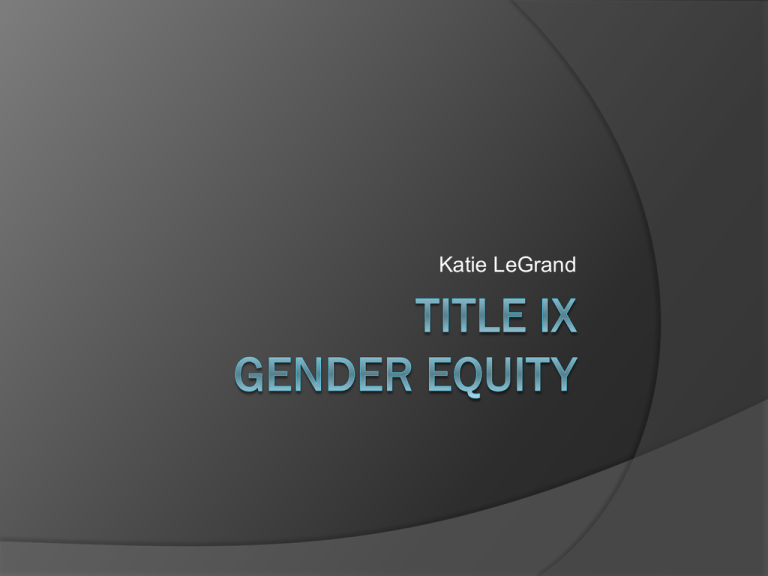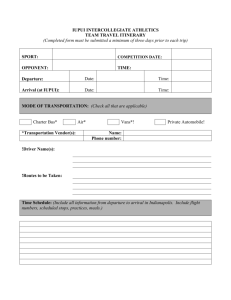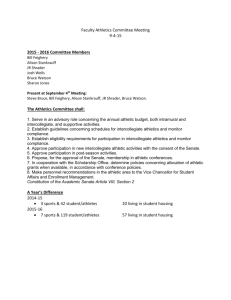
Katie LeGrand
Agenda
History of Title IX
What is Title IX?
Athletics
High School
Collegiate
Relevant Case Law
Current State
What is the law?
Constitution
14th Amendment – Equal Protection
○ No State shall make or enforce any law which shall
abridge the privileges or immunities of citizens of the
United States; nor shall any State deprive any person of
life, liberty, or property, without due process of law;
nor deny to any person within its jurisdiction the equal
protection of the laws.
Federal Law
42 USC $ 1981 – Equal Protection
Equity in Athletics Disclosure Act (EADA)
History
1972
Congress passed Title IX as part of the
Education Amendments
20 USC $ 1681
○ “No person in the United States shall, on the basis
of sex, be excluded from participation in, be
denied the benefits of, or be subjected to
discrimination under any education program or
activity receiving Federal financial assistance”
1974-1975
Education Amendment Act of 1974 prepared by
HEW
Instructed how to implement Title IX compliance
History
1974 Amendment
“No person shall, on the basis of sex, be
excluded from participation in, be treated
differently from another person or otherwise
be discriminated against in any
interscholastic, intercollegiate, club or
intramural athletics offered by a recipient,
and no recipient shall provide any such
athletics separately on such basis.”
History
1974 Amendment
Selection of sports & levels of competition
Equipment & supplies
Scheduling of games & practice times
Travel & per diem allowance
Opportunity for coaching and tutoring
Coaches salaries
Locker rooms, practice & competition sites
Medical & training services
Housing & dining services
Publicity
History
1979
OCR Policy Interpretation
Three Prong Test
○ Whether intercollegiate level participation opportunities for
male and female students are provided in numbers
substantially proportionate to their respective enrollments
○ Where the members of one sex have been and are
underrepresented among intercollegiate athletes, whether the
institution can show a history and continuing practice of
program expansion which is demonstrably responsive to the
developing interest and abilities of the members of that sex
○ Where the members of one sex are underrepresented among
intercollegiate athletes, and the institution cannot show a
continuing practice of program expansion such as cited above,
whether it can be demonstrated that the interests and abilities
of the members of that sex have been fully and effectively
accommodated by the present program
Grove City College Vs. Bell (1984)
Question: Does Title IX apply only to
programs that receive direct federal
funding within institutions or to programs
that exist within institutions that receive
federal funds?
At stake – the vulnerability of athletic
programs to comply with Title IX.
Who won?
History
1984 – Grove City decision
Enforcement ceased
1988 – Civil Rights Restoration Act
Reiterates that Title IX should be interpreted
through an institution wide, rather then a
program specific approach
Not Just Athletics
Equal treatment
Failure to supervise
/ Peer harassment
Sexual Harassment
/ Assault
Employment
Practices
Effective
Accommodation
Program Elimination
Roster Management
History of Expansion
Treatment Issues
Discrimination
Retaliation
Wrongful termination
Case #1
History
1992- Franklin v. Gwinnett
Supreme Court decision
1996 – OCR – Clarification of
Intercollegiate Athletics Policy Guidance
Must count all athletes receiving benefits
Can choose to cap or eliminate opportunities
for the overrepresented sex
Must be responsive to “female” interest in
sports & demonstrate responses to the
needs and interests
Cohen V. Brown University
BU dropped 4 varsity sports
Men’s golf & water polo
Women’s volleyball & gymnastics
The female students sued in a class
action claiming discrimination
The Supreme Court denied the case
On appeal, the district court found that
BU unlawfully discriminated against the
women’s teams
Not Just Athletics
1997 – OCR – Sexual Harassment
Guidance
Quid Pro Quo
Hostile Environment
1998 – Gebser v. Lago Vista SD
Student can sue for monetary damages
1999 –Davis v. Monroe County BOE
Students have a private right of action when
the harassment is very severe
History
2002 – Title IX at 30 years old
2003 – “Further Clarification”
Continue to use 3-prong test
Title IX does not require cutting or reducing
teams (disfavored)
Aggressively enforce / Work with schools
Private donations must be included
OCR enforcement will be uniform
National Wrestling Coaches
Association v. Dept. of Education
NWCA sought to have the department’s
Title IX enforcement framework
invalidated.
Close link between the commissioned
study and this case
Supreme Court denied hearing the case
District of Columbia Circuit Court held
for the DOE
Jackson v. Birmingham BOE
Roderick Jackson filed a compliant in
court
Fired in retaliation
Complained about inequitable treatment of
his girls team – funding and access to
facilities and equipment
Supreme Court sides for Jackson
Title IX does provide private right of action
Retaliation is intentional
Protects those who are not direct victims
History
2005 – OCR – “Additional Clarification”
Focused on 3rd prong
2010 – OCR –
“Dear Colleague Letter” Athletics
○ Withdrew the 2005 Clarification
“Dear Colleague Letter” Sexual Harassment
○ Guidance for sexual harassment, bullying, and
sexual violence
2011 – OCR – “Dear Colleague Letter”
Sexual Harassment
Case #2
Jennings v. North Carolina 2007
Student at institution receiving federal
funds
Subjected to harassment based on sex
Sufficient to create a hostile
environment
There is a basis for imputing liability to
the institution
Who was the coach?
Current State of Title IX
Biediger v. Quinnipiac University 2010
Cut three sports – WVB, MGO, MTO
Added Competitive Cheerleading
Volleyball students sued
Outcome
Granted Preliminary Injunction
July 2010 – Found not in Compliance with
Title IX
Volleyball was reinstated
40 Years of Title IX
‘10-’11 there were 444,077 athletes
57 % were male
Average NCAA institution has 414 S/A’s
○ 236 males
○ 178 females
Since ‘88-’89
Net gain of 510 men’s teams
2,703 women’s teams
“81-’82 – 74,239 women athletes
Today – 190,953 women athletes
Questions?







